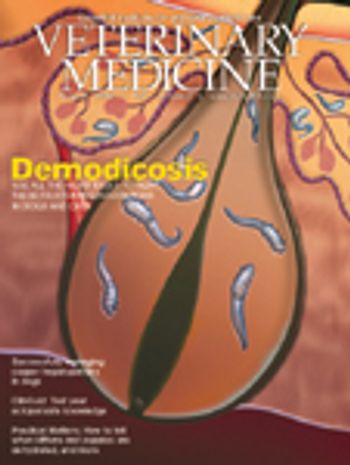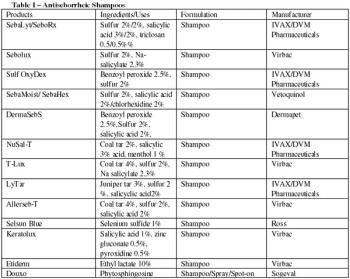
The objective of my presentation today is teach you how to diagnosis and manage a pruritic dog in a safe and cost effective manner.

The objective of my presentation today is teach you how to diagnosis and manage a pruritic dog in a safe and cost effective manner.

It's a painful, disfiguring disease that may strike horses as early as 2 years of age, then over time cause formation of large nodules that interfere with normal pastern movement, permanent skin ulceration and lameness, eventually leading to the animals' early demise.

Although cats appear to not experience as many side effects with glucocorticoids as other species do, adverse reactions can occur, including skin atrophy and fragility, poor wound healing, and a predisposition to diabetes mellitus and congestive heart failure.

Now that cats have overtaken dogs as the most popular pet in American homes, we are seeing more with dermatological problems.

To prevent accidental lacerations during a skin scrape, I use a stainless steel microspatula with a flat-ended blade (Fisher Scientific).

The article "Canine and feline demodicosis" in the August 2008 issue of Veterinary Medicine was well-written and contained timely information about a timely topic in veterinary medicine.

Chili has had hair loss along the neck and ventrum for the last six months.

There are a variety of keratinization defects that affect specific body locations, some of which are breed or species specific.

Pododermatitis, by definition, is the inflammation and/or infection of the skin and connective tissue of the foot.

Pruritus is the sensation to lick, itch, scratch or chew.

Canine atopic dermatitis (atopy, allergic inhalant dermatitis) is a hereditary, pruritic (itchy) skin disease.

Food allergy is a type I hypersensitivity predominantly but a type III and type IV reaction may also occur.

Numerous skin diseases, other than seborrhea, result in excessive scale and crust formation.

Staphylococcus aureus is an opportunistic pathogen that is normally found on the skin, nasopharnyx, and perineum of humans and animals.

These are all relatively new therapies or new information about the use of these therapies.

The use of topical therapeutics and in particular shampoo therapy, has gained increasing popularity in veterinary dermatology.

Flea allergy dermatitis (FAD) is a hypersensitivity disorder of animals that are sensitized to allergens in flea saliva.

Have your clients fill out this consent form for extralabel use of ivermectin to treat demodicosis in dogs.

All normal dogs have a small number of Demodex species mites that live in their hair follicles. These mites are not visible to the naked eye. But some dogs develop an overgrowth of these mites, a condition called demodicosis, or demodectic mange.

Diagnosis of pruritic dermatopathies requires the dedication of collecting an historical account of the problem complete with all interrelationships of seasonality, in-contact animals, human disease and treatment, including specific drugs, treatment regimens and therapeutic outcome.

A series of dermatologic case presentations.

Pruritus in cats, like other species, can be caused by a multitude of diseases.

Flea allergy continues to be a common condition affecting dogs and cats despite the major advances in the understanding of flea biology, the immune mechanisms of flea allergy and the availability of newer chemicals providing more optimal flea control.

Atopic dermatitis, also known as atopy and previously called allergic inhalant dermatitis, is considered to be a genetically based condition whereby the animal develops an IgE antibody response to environmental proteins resulting in disease, most commonly allergic dermatitis.

Bacterial skin infections represent a common condition affecting the canine and is often recurrent.